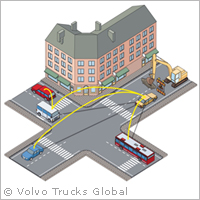SAFESPOT targets better road safety
How can we improve road safety? The answer, say European researchers, is to use cooperative systems technology to detect in advance potentially dangerous situations. The EU-funded SAFESPOT ('Cooperative systems for road safety "Smart Vehicles on Smart Roads") project is developing this technology by using infrastructure and vehicles to communicate safety-related information. The project's 'Safety margin assistant' will extend drivers' awareness of the surrounding environment. SAFESPOT is funded under the Sixth Framework Programme (FP6) to the tune of almost EUR 21 million. Traffic on European roads trebled between 1970 and 2000, and 40,000 people die on roads and 1.7 million people are injured each year. The economic loss stands at EUR 160 billion. SAFESPOT partners believe that combining data from roadside sensors, trucks and cars will significantly help to prevent road accidents, and will fuel understanding of how to avoid life-threatening situations on icy roads, for example. By offering warnings and advice to approaching vehicles, either via roadside signals or directly to onboard units, drivers will have the extra time they need to protect themselves. 'We are already way ahead in the development of this technology,' explained Carl Johan Almqvist of Volvo, a SAFESPOT partner. Launched in 2006, SAFESPOT brings together 51 partners from academia, industry and road administration in 12 European countries. The research is being carried out at six regional test centres. Consortium members believe that telematics (the integrated use of telecommunications and information) will enable vehicles to become more 'intelligent'. Nowadays, vehicles use the Global Positioning System (GPS) to improve their navigation skills, and camera-based systems make lane changing an easier experience. SAFESPOT aims to help vehicles to use communicate with one another using telematics in its 'vehicle-to-vehicle' (V2V) system, which is currently being developed. According to the partners, the project also plans to get the 'vehicle-to-infrastructure' (V2I) system off the ground, effectively establishing a driving support system that boosts active safety. 'This will open the door to an entirely new generation of accident-prevention safety solutions,' Mr Almqvist said. Since the project's launch the partners have defined and tested a number of in-vehicle applications. This includes warnings about poor road conditions and impending frontal collision. At the same time they developed infrastructure-based applications, such as the creation of safety margins for emergency rescue vehicles. In a nutshell, three innovative technologies form the basis of SAFESPOT's cooperative system: accurate cooperative localisation, local dynamic maps and ad hoc communication networking. 'The aim is to pinpoint position with such precision that the margin of error is less than a metre,' commented Johan Fjellström, project manager for the SAFESPOT sector that is being managed by Volvo Technology. Mr Fjellström noted that extensive analysis must be completed before the project ends next year. 'It is necessary to achieve a critical mass for this to be effective,' he said. 'Customers must also immediately benefit from the solutions. The cooperative system concept looks very promising and offers many significant benefits.' SAFESPOT is coordinated by the Italian group Centro Richerche Fiat ScpA, and partners include Continental (Germany), Centre for Research and Technology (Greece), Budapest University of Technology and Economics (Hungary), the Swedish Road Administration (Sweden) and the Netherlands Organisation for Applied Scientific Research.
Countries
Germany, Greece, Hungary, Netherlands, Sweden



